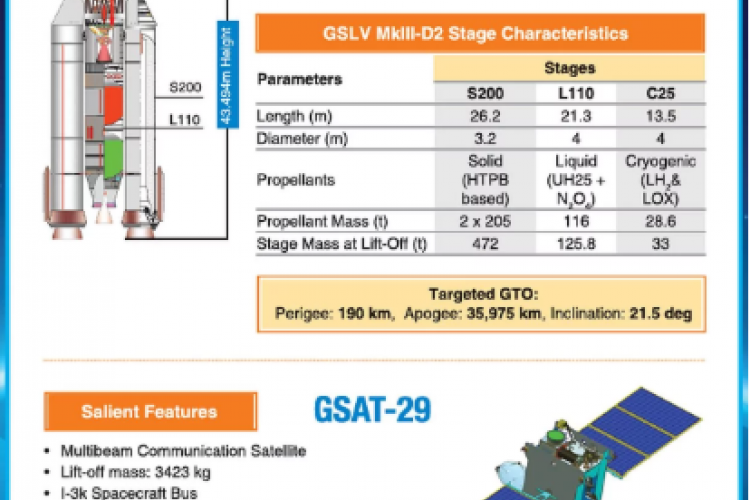GSAT-29
GSAT-29
India’s GSAT-29 communication satellite was successfully launched by the second developmental flight of Geosynchronous Satellite Launch Vehicle MarkIII (GSLV MkIII-D2) from the Satish Dhawan Space Centre (SDSC) SHAR, Sriharikota.GSAT-29 is a high-throughput communication satellite developed by the Indian Space Research Organisation (ISRO). It joins the Indian National Satellite System (INSAT) fleet in geostationary orbit.
GSLV Mk III is a three-stage heavy lift launch vehicle developed by the Indian Space Research Organisation (ISRO).
Two massive boosters with solid propellant constitute the first stage, the core with liquid propellant form the second stage and the cryogenic engine completes the final stage.
The mission aims at providing high-speed bandwidth to Village Resource Centres (VRC) in rural areas. The two Ku and Ka operational payloads will provide communication services to Jammu and Kashmir and Northeast India under Digital India programme. GSAT-29 is the heaviest satellite placed in orbit by an Indian launch vehicle.
The communication satellite, weighing 3,423 kg, is a multiband, multi-beam communication satellite, intended to serve as test bed for new and critical technologies.
In addition, the Q/V-Band communication payload onboard is intended to demonstrate the future high throughput satellite system technologies. Geo High Resolution Camera will carry out high resolution imaging. Optical Communication Payload will demonstrate data transmission at a very high rate through optical communication link.
SIGNIFICANCE of GSLV Mk III
The GSLV Mk III rocket has been designated as the launch vehicle for India’s second moon mission Chandrayaan 2 which is scheduled for January next year and India’s first human space flight which is being targeted for 2022 .
A successful flight for the GSLV Mk III was crucial to expedite ISRO’s moon and man missions.
Secondly, the successful launch of the GSLV Mk III makes the rocket a viable choice for ISRO to use while launching communication satellites weighing over 2,500 kg.
India first ventured on the path of obtaining the cryogenic technology used in the GSLV rockets in 1992 with a two- pronged strategy of purchasing cryogenic engines from Russia and acquiring the technology from the US.
India is among six nations — apart from the US, Russia, France, Japan and China — to possess cryogenic engine technology, a key frontier in rocket science.


 "UPSC-2026-PRELIMS COMBINED MAINS PROGRAMME" NEW BATCH STARTS WITH ORIENTATION ON JULY 7th,2025
"UPSC-2026-PRELIMS COMBINED MAINS PROGRAMME" NEW BATCH STARTS WITH ORIENTATION ON JULY 7th,2025 